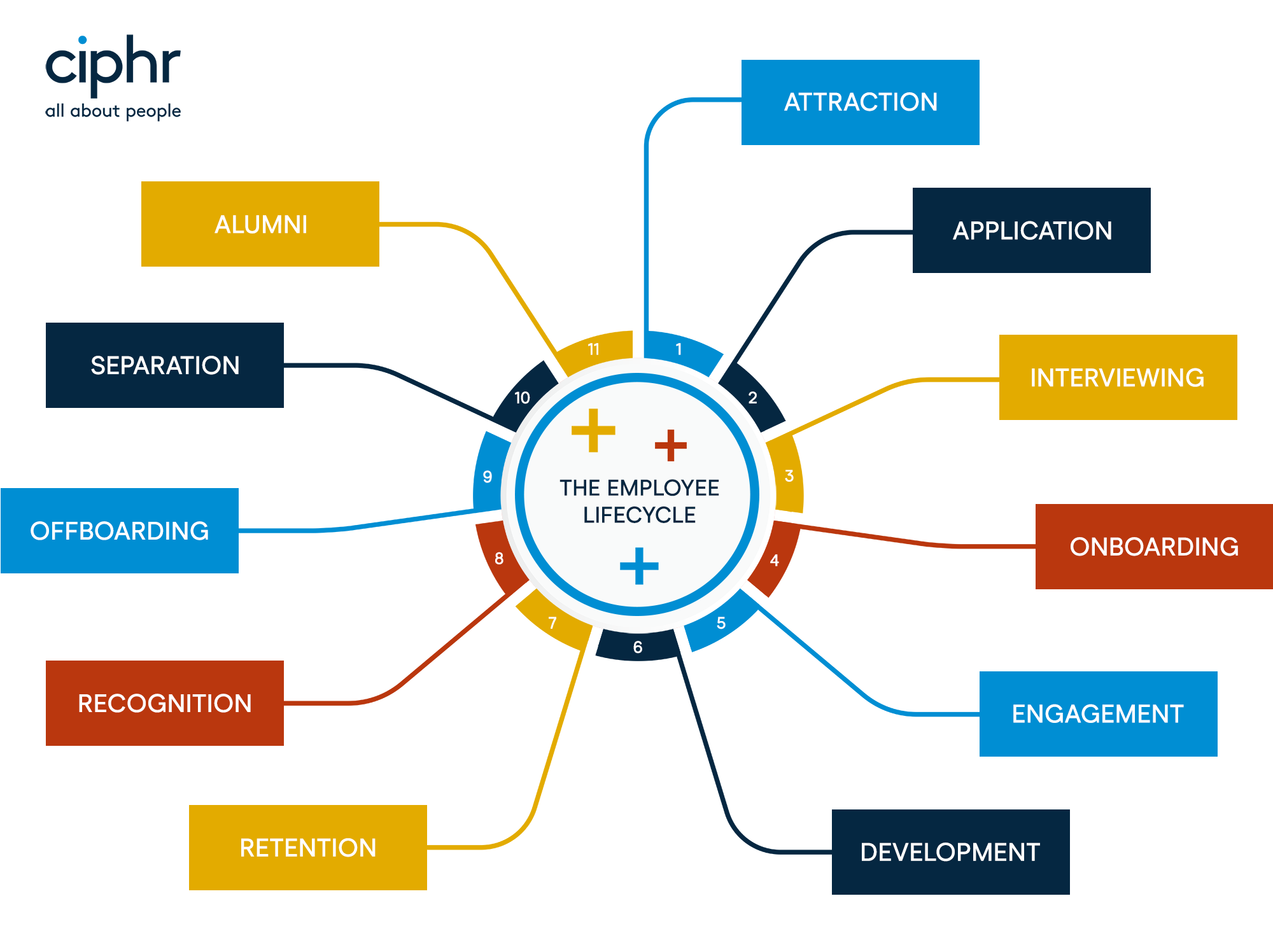Staff will come and go from your business, but can you make each part of the employee lifecycle a good experience? Yes – if you can manage it effectively and create beneficial strategies for each crucial stage
So, you’ve got a new starter at your organisation: congratulations! That’s great news for both your employee and you as an employer – for now, at least. What your HR team does over the next few weeks and months may determine whether your recent recruit will stay with you for a number of years, or go elsewhere. Then you’ll have to start the cycle again.
People will come and go from your business but, as an HR professional, your role is to ensure you hire the best people and then retain that top talent by offering development opportunities and brilliant benefits. And, when someone leaves, make the experience as positive as possible.
This employee lifecycle will evolve during a person’s time with your business. Even your most loyal staff will go one day, so you need to be prepared for every stage of your workers’ time with you. Here’s why it’s important to your organisation, how to improve each stage of the cycle, and technology’s role in the process.
In this article
- Definition of the ’employee lifecycle’
- How many stages are there in a typical employee lifecycle?
- Why is it important to understand your organisation’s employee lifecycle?
- How does HR software fit into the employee lifecycle?
Definition of the ‘employee lifecycle’
This organisational model can be used by HR professionals to show the employee journey, demonstrating how each person can both progress through and engage with your organisation. The employee lifecycle is a representation of staff experience that gives you a framework for engagement activities. It’s similar to the customer lifecycle, because as the experience of your employees is just as important as your customers’.
The lifecycle starts when a potential candidate finds out about a job opportunity. It will then continue through the recruitment and onboarding process, the time they spend with your company, and then what they encounter post-employment when they leave.
The engagement strategies you implement here may then be a great benefit to your company. Thinking about your organisation’s employee lifecycle could help your HR team boost success, improve morale, improve employee engagement and lower your staff turnover rate.
The employee lifecycle will likely be defined by your HR or people team, but it’s not their sole responsibility. Everyone in your organisation will have an impact on your people’s experiences at work.
How many stages are there in a typical employee lifecycle?

The size of your organisation, the industry in which you work, plus the roles of the staff who join you, mean the specific steps of your organisation’s employee lifecycle may be different to other companies’. Yet the path from joining to leaving will be broadly similar.
Some organisations will have a comprehensive cycle with small steps, while others may put some of these together so there are fewer stages. What’s in each stage will depend on the company and its culture. They may include:
- Attraction: it’s the first time someone discovers your organisation, where they may learn more through a job posting, research or natural discovery
- Application process: this is your first direct interaction with a potential employee. By applying for a vacancy directly, or through your HR recruitment software, Your candidate will find out more about your brand, culture, and the role for which they’re applying
- Interviewing: this important stage allows both the potential employee and employer to assess whether they’re a good match for each other
- Onboarding: here’s where you welcome your new starter into the organisation, and support them as they get acclimatised with their new role. As well as HR, other collaborators might include your IT team and some department managers. Some organisations will use specialist employee onboarding software to support this phase
- Engagement: this stage, which may begin once your employee has been in their new position for some time, will focus on engaging employees with their work and promoting the company’s culture. This will help them feel valued, which will ultimately increase productivity and loyalty
- Development: this is for staff who want to improve skills and advance up through your company. They can gain new responsibilities, work on projects, and receive regular pay rises
- Retention: here’s where you focus on keeping top performers by listening to their feedback, empowering them to improve their work, and making sure they’re comfortable with their day-to-day role
- Recognition: go further than regular rewards (ie good pay and benefits) by frequently recognising employees’ good work. This will increase happiness and team dedication
- Offboarding: can be streamlined by using offboarding software. Hopefully an employee leaves your company on good terms. Plan for a smooth transition of the leaver’s duties to another colleague, and provide training for anyone who will need to temporarily take over responsibilities. Make sure to also prepare for final payments
- Separation: understand why someone is leaving your brand, and get any information that can help make it a better place to work. You may also want to celebrate your leaver’s time at the company with a goodbye event
- Alumni: you don’t need to break links with a former employee. They could be a source of future referrals, and you may wish to work with them again
The employee lifecycle is a crucial part of your organisation’s development: it shouldn’t just include recruitment and retention, but also ensure people expand their skills and create a positive exit. Your business won’t reach its potential if you don’t have the correct people in place, even if you have the best technology and equipment. So, going through the stages of the employee lifecycle will ensure you have the talent to succeed.
Why is it important to understand your organisation’s employee lifecycle?
A significant benefit of your brand’s employee lifecycle is that you’re encouraged to check and improve the employee experience at each stage. The better the time someone has when working for you, the more likely they’ll want to stay loyal and continue with you. This, of course, has a positive effect on retention – which will then affect turnover and the costs associated with recruitment.
The design and implementation of your employee lifecycle will help you to:
- Discover which stages work best, so you can apply these insights elsewhere in the cycle to meet employees’ needs
- Receive feedback so you create better experiences throughout the lifecycle, including those events that haven’t been recognised before now
- Effectively amend poor experiences through this feedback, so you know why you haven’t met expectations and what you need to improve
When you understand the purpose of an employee lifecycle, you can start enhancing the staff experience throughout each stage. While creating learning and development strategies will support employees to build on their skills and reach their potential, you can also boost your reputation as an employer – which will help attract the best people for you to build a driven and committed team.
How does HR software fit into the employee lifecycle?
Human capital management (HCM) solutions feature functionality that supports the whole of the employee lifecycle. Features such as recruitment, payroll, time management (for both absences and working time), learning management and reporting can be personalised to the needs of your company – and its employee lifecycle. Ciphr’s HCM platform, Ciphr Connect, has great connectivity with solutions from other providers, so there won’t be any problems if you’ve got another third-party system already in place for one of the lifecycle stages.
Ciphr Connect can support your HR team at each point of the employee lifecycle, meaning you can improve the experiences of everyone who’s part of your organisation. The four main stages where the platform can help are:
- Recruitment and onboarding: the process of finding the correct person for a role includes pre-screening, reviewing an applicant’s details, and completing background checks – so you need to keep track of each step. Onboarding is when you start setting up access, get paperwork completed, and begin orientation activities such as system training
- Talent, engagement and wellbeing: not only is training crucial when someone starts a new role, but it’s also important when further developing skills so an employee continues adding value to your brand
- Management and productivity: understand what inspires your employees, and discover areas in which they need or want to develop. This is also where HR and management colleagues can collaborate to create succession plans
- Reward and pay: you’ll find it helpful here to have payroll and benefits features in this HCM software; having a good compensation plan will also help retain employees,
If you want to invest in HCM software that can be adapted to your organisation’s requirements, then contact Ciphr for a demonstration of our integrated HR, recruitment and onboarding software. We’ll help you create a better, more engaging employee lifecycle through our range of sophisticated solutions.
